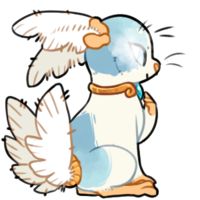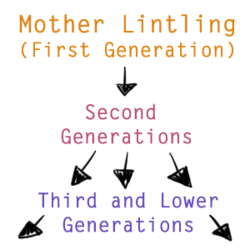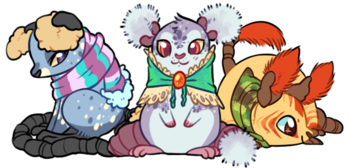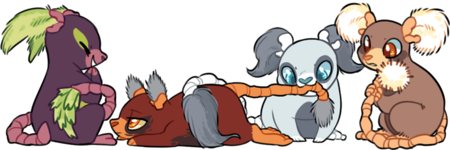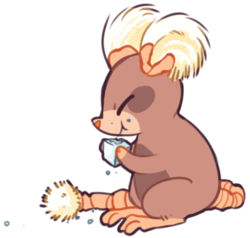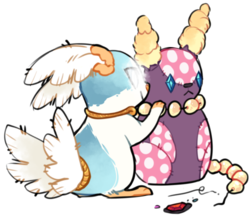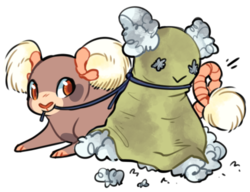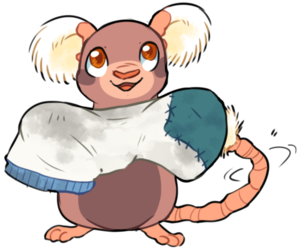Difference between revisions of "Lintling"
(→Physical Characteristics) |
(→Diet) |
||
| Line 56: | Line 56: | ||
== Diet == | == Diet == | ||
[[File:Acorn sugarcube 400.png|right|250px]] | [[File:Acorn sugarcube 400.png|right|250px]] | ||
| − | Much like [[Pillowing]]s it's assumed that lintlings do not possess internal organs. No one has really caught one to examine or dissect to be sure. They appear to have functioning mouths | + | Much like [[Pillowing]]s, it's assumed that lintlings do not possess internal organs. No one has really caught one to examine or dissect to be sure. They appear to have functioning mouths with tongues, teeth, and the ability to swallow regardless. |
| + | From careful observation, we have learned that injured lintlings will eat bits of string or other materials that will patch them from the inside out. Usually the stronger the magic they have, the better they heal. Injured second generation lintlings have been seen consuming a piece of string, only to then see the same string flow out of a tear to immediately stitch the lintling back together. | ||
| − | + | Later generation lintligns have been seen eating food such as sugar cubes and bread crumbs which seems to lengthen their lifespan. They do not have an ever lasting supply of life magic, so they look to find new ways to sustain themselves. Mother can't be everywhere for all lintlings. Regardless of not having any internal organs, they seem to love collecting crumbs and various other edible goods to devour. Strangely enough they don't seem to produce any waste from the act of eating. Instead the entire substance is transformed into energy and replenishes a portion of their life-magic. One of the lintlings' favorite treats is sugar. It's known you can fairly easily lure out lintlings with sugar cubes. | |
| − | + | ||
| − | + | ||
| − | One of the | + | |
== Behavior and Interaction == | == Behavior and Interaction == | ||
Revision as of 22:16, 11 October 2014
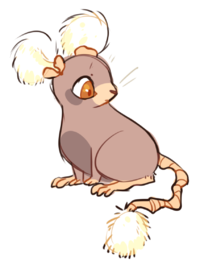 | |
| ( A Closed Species ) | |
|---|---|
|
DA Group: Clo-Critters Terms of Use | |
Created by the same artisan who invented the Pillowings. They were created with the same intent as pillowings to be a smaller version of a comfort creature. A travel sized buddy if you will. However the same magic heart token used to create pillowings proved to be too powerful for the small lintling body to easily be controlled. The first created lintling became full of life and even self aware. It seemed to crave more and more activities that didn't benefit it's owner. When it realized it's needs were not going to be met, the lintling escaped.
No one except for the artisan knew where all the lintlings came from, or even what they were at first. Some how the first lintling that escaped found a way to procreate more and more of it's kind. The lintlings created from the first followed their lead by creating more of their own. They quickly become the residents of Clo's newest pest! Spreading out and moving into comfortable homes in swarms to thrive and create even more lintlings. No one really knows how to stop them, but as an aid to help keep them under control Pillowings have been given the drive to hunt and chase out lintlings from their house holds.
Contents
Physical Characteristics
Lintlings can vary greatly in a variety of characteristics (A visual guide will be added in later like the pillowings Feature Guide!). Their size often ranging anywhere from that of a small field mouse to an extremely large rat. However most lintlings are roughly 6"-8" from tip to tail. The smaller size gives them more room to crawl into furniture, walls, and tiny crawl spaces. Larger lintlings have a harder time getting around which makes their survival rate lower.
The lintling that is now known as Mother (the first of the species) is the most finely crafted of all lintlings. Thanks to her life giving magic, there are not even any seams to be seen on her. Instead, her fabric now turned into a fine shimmering fur. It is clear the very heart of the artisan who created her gave a special piece of their self into this small creature. In return, Mother does the same with her pups, giving them not only magic but the inspiration to continue to grow and create more vibrant designs.
Second Generation lintlings are empowered with the Mother's creativity and seek to replicate it as she did for them. They craft more and more wonderful lintlings seeking to make their mother proud of them through their dedication. They do not have the finesse of their Mother, but they make due with what they have on paw. As there is loss in quality between Mother and her children, so too is there between the second and third generations.
The longer their ancestry, the lower quality each lintling is, and the less magic is imparted on it by its creator. Those three or further generations from mother have very little creativity in them, and so tend to make less unique lintlings as their offspring. Later-generation lintlings all tend back toward the generic look of a field mouse. Enough generations down, the lintlings do not even have enough magic left in them to inspire them to create, and so they cease to strengthen the species.
First Generation
First Generation refers to the lintlings that were crafted and enchanted by artisans. As they were an attempt at creating a new breed of pillowing, they have a heart token in their chest giving them the same permanently self-sustaining energy of the pillowings. However they also have the ability to repair themselves and other lintlings. The heart tokens magic is too great for such a small body which is why it drives the lintling to create more and more of it's kind. It imparts some of this excess into its children as a safe method to siphon off the magic before it overwhelms her.
So far we only know of one hand crafted lintling. This lintling is referred to as Mother (shown on the left). Her specially detailed wing-like fluffs are specially made by human hands, as is the gold collar she wears around her neck as decoration.
Second Generation
Second generation lintlings are those that were personally made by Mother herself. These lintlings have a much higher magic store than other later generation lintlings. They are often made with special features like Mother: special ears, tails, and even clothing/accessories! Mother has an enormous amount of creative energy, and is always making new and unique children. Second gen lintlings often retain some of that special creative magic that Mother bestowed upon them, giving them the ability to create and craft like her (if not as expertly). Because Mother can not watch over all of her pups, she relies on the aid of her second gen pups to be leaders and watch over the rest of the lintlings when she isn't there to help.
Third and Later Generations
Third and later generations of lintlings are the more average of the bunch when it comes to lintlings. They are the most common lintling you will ever see around your home. Their main job is to survive and collect goods to create more lintlings. If they do not have Mother there with them or a second gen leader they will create lintlings themselves with their own resources and magic. These lintlings are more mouse and rat like, a little more average and plain.
Later generation lintlings have to be cautious though when spending their magic to help create more lintlings. Because they don't have the endless supply of magic like Lintling Mother or a large store of it like their creators, they can easily run out of the very magic that keeps them active and alive. Without it, they will wither and die. This is very common in lintling colonies that do not have a second gen lintling leader to aid them. Because later generations of lintlings don't have large magic supplies for creating they often are left to lower tasks as making the nests bigger and more spacious or collecting supplies so that the older generation lintlings can build with them as part of their hierarchy.
Habitat
Lintlings tend to live where ever there is intelligent life. contact. They aren't necessarily looking to make contact with humans or humanoid like figures, but they love the comfort and warmth of their well built homes. Lintlings do not survive well outside in the wild where weather conditions and predators can easily harm them. So instead they stick to mostly indoor enclosures.
Generally seeking out safety in whatever manmade structures they can find, lintlings are known to make their homes in warm comfortable houses where there are a variety of supplies available to help create large nests, and more importantly, and further generations of lintlings to add to their colonies. The small creatures must meet these needs by finding homes with excess clutter and usually soft carpeting that traps lint. A home of mostly hard surfaces with very little in it, will deter lintlings from colonizing.
These creatures can be quite destructive for their size. Ordinarily, a lintling will only look for loose or fallen supplies: buttons under the couches, lint in the carpets, tooth picks on the floor of the kitchens, etc. Any little discarded things they will take without anyone knowing any better. However if there is a lack of discarded materials easily available, the lintlings can become desperate for more supplies. Stressed lintlings have even been known to chew and wreck the furniture and goods inside of their adopted home. Taking large chunks of drapes, blankets, rugs, anything at all they can chew through and take home with them.
Lintlings normally nest in the walls, but occasionally will make a comfortable next in the attic or basements. In warmer climates, colonies have been found in garages and barns as well. Particularly rare, but known to happen, some lintlings will make nests in plain sight, often hollowing out something like an old recliner chair or couch to live inside. Since most tend to view lintlings as a pest, these types of nests are very rare except in abandoned homes.
Diet
Much like Pillowings, it's assumed that lintlings do not possess internal organs. No one has really caught one to examine or dissect to be sure. They appear to have functioning mouths with tongues, teeth, and the ability to swallow regardless.
From careful observation, we have learned that injured lintlings will eat bits of string or other materials that will patch them from the inside out. Usually the stronger the magic they have, the better they heal. Injured second generation lintlings have been seen consuming a piece of string, only to then see the same string flow out of a tear to immediately stitch the lintling back together.
Later generation lintligns have been seen eating food such as sugar cubes and bread crumbs which seems to lengthen their lifespan. They do not have an ever lasting supply of life magic, so they look to find new ways to sustain themselves. Mother can't be everywhere for all lintlings. Regardless of not having any internal organs, they seem to love collecting crumbs and various other edible goods to devour. Strangely enough they don't seem to produce any waste from the act of eating. Instead the entire substance is transformed into energy and replenishes a portion of their life-magic. One of the lintlings' favorite treats is sugar. It's known you can fairly easily lure out lintlings with sugar cubes.
Behavior and Interaction
Lintlings are extremely social. They tend to build off of one another and start from small family groups until they build larger colonies. Lintlings are extremely skittish and timid creatures. They do well to interact with each other and enjoy play, but with other creatures they are easily spooked back into their holes and nests.
Lintlings all like to huddle together when it comes time to rest, a natural way to rub each others scent on the family to make sure they all know they belong together. Careful patching and grooming happens often to help build trust and keep firm bonds with each other. Lintlings are actually proven to be very intelligent and the more creative lintlings will even craft goods to help make their chores and tasks easier. It's been seen that lintlings understand how to make ropes and ladders to climb down high surfaces. They even will craft goods for each other like clothing or accessories as gifts to show their bonds. Lintlings even love to craft goods for themselves to make them more comfortable.
Colonies
They tend to live in large groups referred to as colonies. Usually this starts with just one to a hand full of lintlings to create a large colony for just one house hold. If the Lintling Mother or any second generation lintlings are present, the colony will grow fast and large with the extra supply of life giving magic. If it is just lower generation lintlings they will take a lot more time to develop a large enough group or colony because it strains and depletes their life force. If a lintling is not careful and gives up too much of it's life sustaining magic to procreate more lintlings it will eventually grow weary and wither away.
Lintlings will often live in a social hierarchy much like dogs. No lintling would dare challenge Lintling Mother, she is considered a deity among lintlings and is to be respected and protected at all costs. Second generation lintlings are usually natural born leaders and creators. If there is more than one 2nd gen they will have to fight and bicker as to who tops who. If it's only one 2nd gen in a group of lower gens the 2nd will almost always come to lead them and do their best to look after the colony. If a 2nd gen is not present at all the lower gens will just fight among themselves until a new social hierarchy has been set in stone.
Communication
Lintlings communicate heavily through body language, as a means to stay extra quiet while out scouting the areas for more food or materials. Lintlings are always careful to try and not alert pillowings or other living things of their presence. Lintlings are not able to produce human speech. But much like ordinary mice and rats they make the following noises.
- Squeaks
- Squeals
- Yelps
- Whimpers
- Clicking or Chirping
- Growls or Hissing
Reproduction
Lintlings do not procreate in the traditional sense like two animals mating. Because lintlings have no direct internal organs they do not technically have any sort of gender to aid them in production. Instead lintlings have magic sealed inside of them giving them life force. This life force animates the lintlings and gives them motivation, will to survive, and the inspiration to create.
A single lintling can create another lintling all on their own. Lintlings will collect all sorts of makeshift supplies in other to craft a shape that looks similar to a lintling. The best example of this would be like building a snow make, creating a base then decorating it to how you liked. Once the lintlings have created this crude lumpy base of a lintling they will find a posture best suited to them. Pressing noses together, foreheads, hugging, any type of physical touch. The lintling then will offer it's own life force to the crudely crafted lintling until a blinding light glows from it and in a poof, a living lintling will be left sitting where the pile of supplies once was. A new lintling as been born, or made to be technical.
Lintlings must be very cautious will how they spend their magic. A basic 3rd gen or lower gen lintling could very well live for 5 years if it chose not to spend a bit of their magic creating more lintlings. Eventually the magic in a lower gen lintling will grow weaker and weaker until it completely fades away leaving nothing but the limp plush like body of a linting behind. The same thing will eventually happen to 2nd gen lintlings, their life spans have been gauged to last some where between 10-15 years, double some times triple of what lower gen lintlings get. As for the Lintling Mother, no one knows if she will wither away at some point. She has not shown any weakness since her creation and has even been known to give out doses of her own life force to aid her pups if they are lacking life force magic.
The magical thing about lintlings is that they can offer to give up bits of their own life force to family, partners, or any lintling at all to help keep them surviving. If they are injured there is a high risk they lost a lot of life force and a family of lintlings will offer up a small piece of themselves to help restore the injured lintling. Lintlings that regularly use their magic to create more lintlings will often cut their life spans in half. They give up large portions of themselves to make more of their kind.
Taming and Care
Because lintlings are skittish by nature, it is naturally very difficult to approach one without startling it. The moment you come home or enter a room, most of the lintlings will have run to hide or back into their holes in retreat. Because of their intelligence they seem to remember time lines of how things work around certain house holds. When you're gone from work, what rooms are used the most, all sorts of routines and use them to their advantage. Even laying out traps to cage or trap lintlings seems to prove fruitless with these little creatures. They work in groups to free their fellows and keep themselves off the radar of the host.
There are few things that seem to be irresistible for lintlings, making it easier to lure them out. Shiny items like rhinestones, buttons, fabric, thread, and various other building like materials. They also seem to favor edible items like bread, vegetables, rice, and even sugar. If there was something that a lintling could not resist, it's sugar. People often use sugar cubes to try and regularly spot lintlings in their home by leaving them in obvious places while they relax around the home. Lintlings can't seem to wait for the host to leave before trying to scamper over to snag it before the host notices!
The best way to initiate contact with a lintling is to remain in the home and be patient. Keeping a very calm and quite presence helps them grow more at ease of your presence. If you happen to see a lintling out of the corner of your eye feel free to leave out a snack or even a small random item for the lintling to notice. Lintlings will eventually take these items as peace offerings and gradually come more and more into the open with your presence.
So long as you remain calm and patient, lintlings may even approach you openly for goods or snacks. While they might not right away take them straight from your hands, you can work your way up by setting it out an arms length from yourself and sitting very still for them to approach you and take the items. In time you can close the gap and hopefully the lintling will follow along in not seeing you as a threat.
As Pets
Once you have successfully approached and connected with a lintling, you will find them to be extremely interesting pets. While they don't have the same needs as cats or dogs when it comes to food or exercise, they will still need to be trained to focus their crafting energy to not be so destructive in your home. Gently tap surfaces to get their attention and tell them no if you see them chewing on things or taking things you don't want them to have. Lintlings will not understand this right away, so please don't get frustrated! You instead will need to make sure you have goods on hand to provide them with instead of taking a chunk of your new blanket. Go to the thrift store and pick up an old pillow case for them to chew up or buttons for hoarding.
Hopefully in time you can even coax them to not live in your walls by providing them with new living arrangements. Examples would be a large chest for them to custom to their liking, large open-like cages that they can come and go freely in, letting them know this is a building-SAFE zone for them to play in. When your lintlings have a happy and fulfilled house hold you'll find them actually being productive to your house hold! They will begin to go out of their way repairing things around your house. They will patch clothing, sew up tears in your blankets, leave out beautiful new ornamental gifts to show their appreciation for you supplying them with goods and food to restore their energy.
You can have some influence over lintlings as to where their creative energies are put, but sadly that's about the end of it. They may interact with you and even sit with you as you watch television or read, even happily nap with you. But you can not control or help their social hierarchy or life spans. If a lintling were to grow weaker, there would be nothing that you could to other than providing food to try and help replenish it's energy. But sometimes that's just not enough to sustain them. You must rely on the other lintlings to take care of one another and accept you will always just be an outside influence of their lives.
Still lintlings will appreciate and may even love you as a host. They may even try to get you to join their colony by providing you with materials to help them create more things, lintlings are naturally drawn to creative spirits who like to craft or make things like they do. Scrap booking, knitting, wood carving, any sort of creative tasks fascinates them. They will be easily startled if you bring strangers into your home and often hide. It will be hard to introduce them to new people because of their timid nature, but so long as you bring them around often enough and tell them to keep quiet and calm they eventually will follow your interest and check out the new person in their home.
Good luck taming your lintlings!
